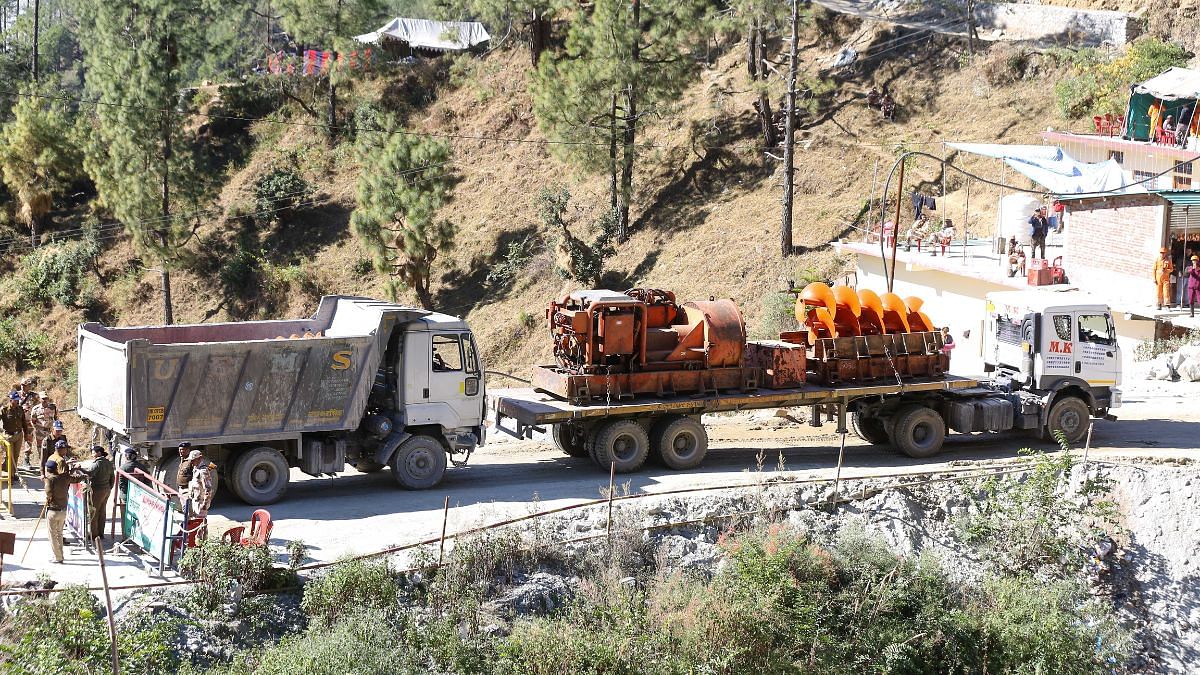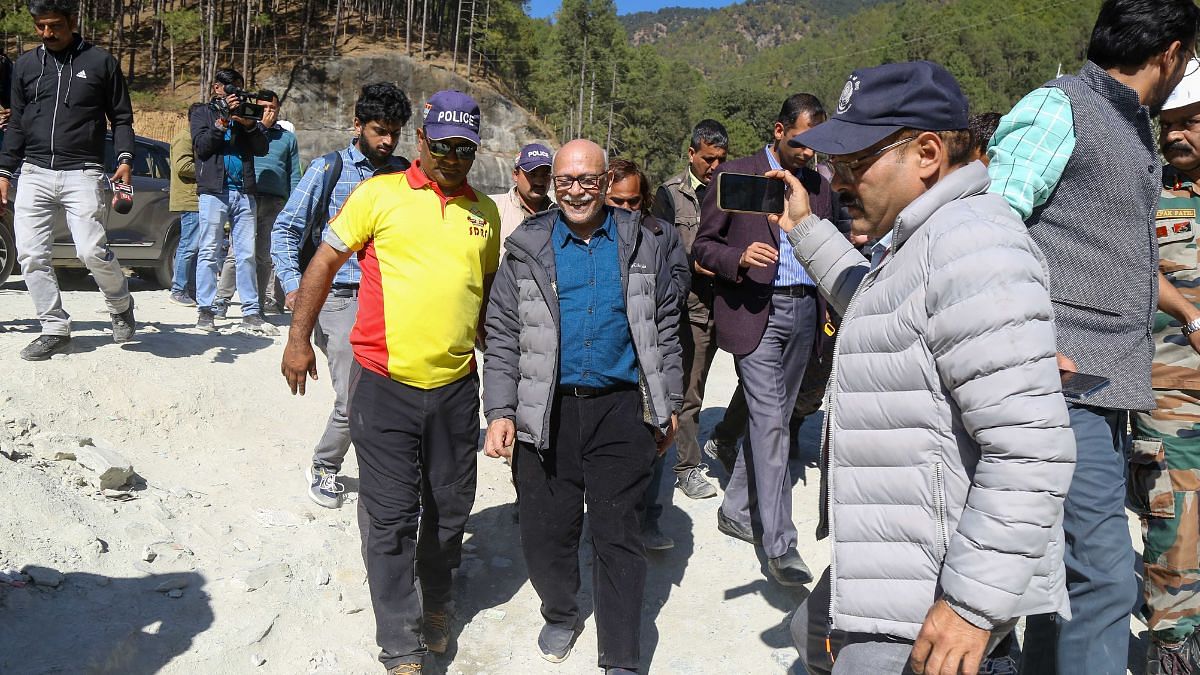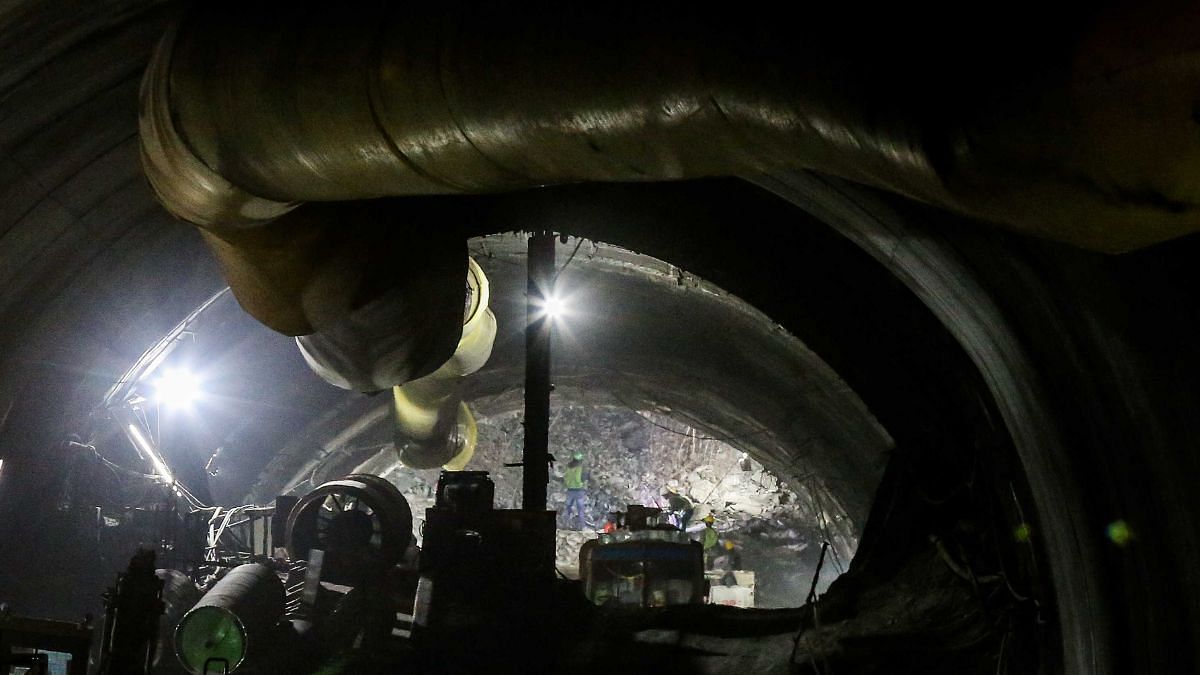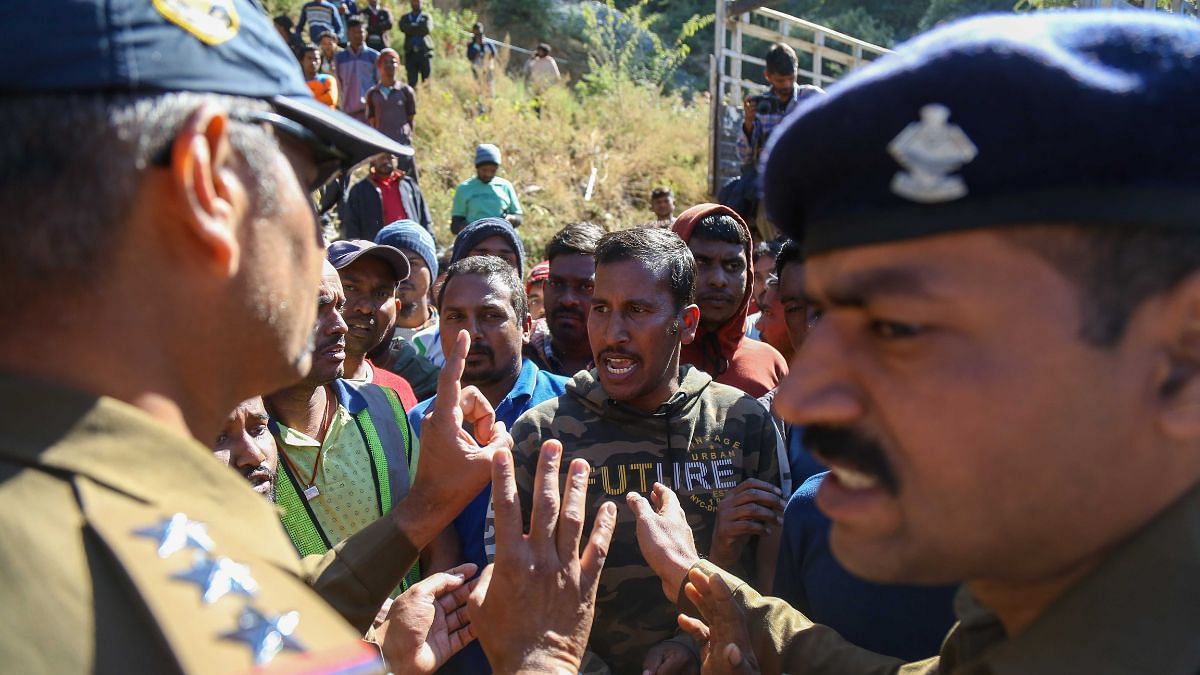Uttarkashi: Six days after a section of the under-construction Silkyara Tunnel in Uttarakhand’s Uttarkashi district collapsed, trapping a group of construction workers inside, the army was deployed Saturday to “build a track” to facilitate vertical drilling for rescue operations.
“We have to build around 320 meters of track so that we can take the drilling rig to the top. Our target is that we have to complete it by tomorrow [Sunday]. We are working at war footing,” an army personnel was quoted as saying by a news agency Saturday.
Meanwhile, the number of those believed to be trapped inside the tunnel has reached 41, with the name of Deepak Kumar Patel, a worker from Bihar’s Muzaffarpur, being added to the list released by the Uttarkashi District Emergency Operation Center Saturday.
Those part of the rescue operations include teams from the National Disaster Response Force (NDRF), State Disaster Response Force (SDRF), Indo-Tibetan Border Police (ITBP), and Border Roads Organization (BRO).
At around 5 am on 12 November, a 30-meter section of the under-construction Silkyara Tunnel collapsed. Since then, efforts have been on to rescue the trapped men, but have hit one snag after another. A specialised auger machine imported from the US — and airlifted from Delhi after the first auger broke down Tuesday — was being used to drill a path to the trapped men, but that too broke down Friday.
Drilling work began again Saturday evening after a third augur machine reached the site from Indore.

“We were trying to reach them [the trapped workers] horizontally, now we will also try vertically… A spot right above the tunnel has been identified and marked. A hole will be drilled from there to reach them. The depth of the hole would be approximately 300-350 feet…The horizontal attempt of rescue would also begin from one end of the tunnel,” D.P. Baluni, district forest officer (DFO), Uttarkashi, who visited the site with a team from the Prime Minister’s Office (PMO) Saturday, was quoted as saying by a news agency.
By Saturday evening, preparation for the vertical digging had begun.
According to information shared by a BRO team present at the site, temporary roads will be constructed on both sides of the mountain by Sunday to facilitate drilling from the top. The drilling and rescue of the workers will be handled by the NDRF and the process is likely to take three to four days, sources told ThePrint.
Addressing the media in Dehradun Saturday, Uttarakhand Chief Minister Pushkar Singh Dhami said the government will arrange for food and accommodation for friends and families of the trapped workers, who have gathered at the disaster site to await the return of their loved ones.
The CM added that rescue work being undertaken was based on the experiences gained from previous tunnel rescues conducted both in the country and around the world.
But workers who have been trapped inside the tunnel for close to a week now appear to be slowly losing hope.
“Seems like the end is near”, a construction worker from Bihar, trapped inside the tunnel told his brother Saturday, as the two communicated through one of the pipes that have been drilled in to allow rescue workers to send oxygen, water and food to those trapped inside. The pipes are also being used by worried family members to shout down into the tunnel in an attempt to reach out to their loved ones.
“The condition of all the people trapped inside is not good,” said the Bihar worker’s brother, on condition of anonymity.
The pessimism voiced by the trapped worker and his brother are in sharp contradiction to official assurances about the condition of those inside.
Uttarkashi senior superintendent of police Arpan Yaduvanshi had said Friday that the workers trapped inside are in fine condition.
The Silkyara Tunnel (or the Silkyara-Barkot tunnel) is part of the central government’s ambitious Char Dham all-weather road project. Being built at an estimated cost of around Rs 12,000 crore, it aims to reduce the distance from Uttarkashi to Yamunotri by approximately 25 kilometres.
Environmentalists, however, raise concerns about the safety of such projects in the Himalayas and push for detailed study of the stability of the terrain before undertaking such work.
Also read: Disasters put focus on cities’ ‘carrying capacity’. It’s a textbook concept, planners don’t use it
Hope and desperation
The mood at the disaster shifts between optimism and fear, as family members often get varying communications from within.
Rajni (identified by first name only) appeared calmer after speaking to her husband, Birendra Kishku, a worker from Bihar who is among the trapped workers, through the pipe. “He asked about the children, he is fine,” she said, adding that the administration had assured her that her husband would be rescued in two days.
But Devashish (identified by first name only), also from Bihar, feared his brother-in-law “was in a bad condition”.

Tempers are often frayed, as some of those present at the site accuse the administration of being negligent in its attempt at rescuing the trapped workers.
“No one is working and hence today it has been so many days and our colleagues have not been able to come out,” said an angry worker who was fortunate to not have been among those trapped.
A second worker asked a police officer present at the site, “How would you feel if we locked you inside for ten days and gave you food, but did not allow you to use the toilet?”
The concern is echoed by a rescue worker who told ThePrint on condition of anonymity, “All the workers are safe at the moment and food is being delivered to them”, but while there is electricity and water inside, “one cannot be kept trapped indefinitely, and the rescue process is relatively slow”.
‘When the gods are angry…’
Meanwhile, a temporary temple has been set up at the mouth of the tunnel, with a section of locals fearing that the collapse could be a sign of the gods being upset.
According to the residents of the area there used to be a temple of Boukhnag (Vasuki Nag) at the site, but it was shifted by the construction company — Navayuga Engineering Company Limited, which is building the tunnel on behalf of the National Highways and Infrastructure Development Corporation Limited (NHIDCL). The talk veers to other natural disasters in the state, as the residents seek a divine explanation behind them.
“When the Gods are angry, living beings cannot survive,” is the shared feeling among them.
“An attempt was made to displace our deity in the past too. Work on that tunnel remains incomplete. Even now, the disturbance caused to the temple here is preventing those trapped inside from coming out,” claimed Dhirpal Singh, a resident.
The idea of divine displeasure seems to have caught on. A police officer speaking on condition of anonymity told ThePrint that “Whoever is going to work in the tunnel [for rescue operations] is doing so after apologising to the deity and seeking blessings.”
Meanwhile, the priest who set up the temple and is performing the puja there told the media that it was crucial for the people trapped inside to be able to come out.
According to some officials from the construction company present at the site, work on the tunnel started in 2018 and since then there have been three similar mishaps — in 2019, 2021 and 2022, when sections of the tunnel had collapsed. However, no workers were injured in any of these incidents. they claimed.
ThePrint has reached NHIDCL for comment on WhatsApp for confirmation and details about these claimed previous mishaps, the article will be updated once a response is received.
‘Need for comprehensive environmental impact assessments’
According to media reports, geologist S.P. Sati had previously highlighted that tunnels in the Himalayan region be constructed without blasting to avoid causing cracks in the mountain.
Y.P. Sundriyal, geologist and professor of the Hemwati Nandan Bahuguna Garhwal University, has also alleged that negligence on the part of NHIDCL led to the incident.
“The absence of ground penetrating radar (GPR) in tunnel construction, the lack of emergency exits, and the absence of steel pipes or bars at 2-3 feet intervals were among the causes of the incident,” he told ThePrint, adding that there is a lack of accountability in such cases.
ThePrint visited the NHIDCL office for a comment. This report will be updated if and when a response is received.

While pointing out that construction work in these areas pose a constant danger to human life, environmentalist Seema Javed emphasised the need for more in-depth environmental studies and geo-mapping before undertaking such projects.
”There is a risk of landslides in hilly areas, which can be caused by digging, deforestation or heavy rainfall. Construction activities [in such areas] can lead to deforestation, habitat disruption and soil erosion”, she said.
Javed added: “To avoid this, one should conduct thorough comprehensive environmental impact assessments (EIAs) before construction to understand the environmental consequences and implement mitigating measures. The stability of the terrain should also be evaluated to assess the risk of landslides, rockfalls, and avalanches.”
According to the environmentalist, designing infrastructure projects with the region’s specific topography and climate in mind, incorporating features that can withstand natural challenges, providing workers with proper training on safety measures and protocols for working in mountainous regions, and implementing real-time monitoring systems for weather conditions, geological stability and other environmental factors to anticipate and respond to potential threats, could go a long way in helping combat such potential threats.
(Edited by Poulomi Banerjee)
Also read: Murmure & kishmish sent, augers at work — rescue of 40 men trapped in Uttarkashi tunnel enters day 5

